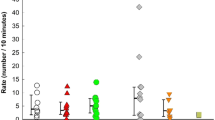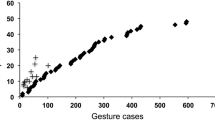Abstract
Observations of chimpanzee gestural communication are reported. The observations represent the third longitudinal time point of an ongoing study of the Yerkes Primate Center Field Station chimpanzee group. In contrast to observations at the first two time points, the current observations are of a new generation of infants and juveniles. There were two questions. The first concerned how young chimpanzees used their gestures, with special focus on the flexibility or intentionality displayed. It was found that youngsters quite often used the same gesture in different contexts, and different gestures in the same context. In addition, they sometimes used gestures in combinations in a single social encounter, these combinations did not convey intentions that could not be conveyed by the component gestures, however. It was also found that individuals adjusted their choice of signals depending on the attentional state of the recipient. The second question was how chimpanzees acquired their gestural signals. In general, it was found that there was little consistency in the use of gestures among individuals, especially for non-play gestures, with much individual variability both within and across generations. There were also a number of idiosyncratic gestures used by single individuals at each time point. It was concluded from these results that youngsters were not imitatively learning their communicatory gestures from conspecifics, but rather that they were individually conventionalizing them with each other. Implications of these findings for the understanding of chimpanzee communication and social learning are discussed.
Similar content being viewed by others
References
Acredolo, L. &S. Goodwin, 1988. Symbolic gesturing in normal infants.Child Develop., 59: 450–466.
Bakeman, R. &J. Gottman, 1986.Observing Interaction: An Introduction to Sequential Analysis. Cambridge Univ. Press, Cambridge.
Bates, E., 1976.Language and Context: The Acquisition of Pragmatics. Academic Press, New York.
————, 1979.The Emergence of Symbols: Cognition and Communication in Infancy. Academic Press, New York.
Berdecio, S. & A. Nash, 1981. Chimpanzee visual communication: facial, gestural, and postural expressive movements in young, captive chimpanzees. Arizona State Univ. Research Papers, No. 26.
Bruner, J., 1981. Intention in the structure of action and interaction. In:Advances in Infancy Research, Vol. 1,L. Lipsett (ed.), Ablex, Norwood, New Jersey, pp. 129–152.
Galef, B., 1988. Imitation in animals: history, definition, and interpretation of data from the psychological laboratory. In:Social Learning: Psychological and Biological Perspectives,T. Zentall &B. Galef (eds.), Erlbaum, Norwood, New Jersey, pp. 3–28.
Ghiglieri, M., 1984.The Chimpanzees of the Kibale Forest. Columbia Univ. Press, New York.
Gomez, J., 1991. Visual behavior as a window for reading the mind of others in primates. In:Natural Theories of Mind,A. Whiten (ed.), Blackwell, New York, pp. 195–207.
Goodall, J., 1968. A preliminary report on expressive movements and communication in the Gombe Stream chimpanzees. In:Primates: Studies in Adaptation and Variability,P. Jay (ed.), Holt, Rinehart, & Winston, New York, pp. 313–374.
————, 1986.The Chimpanzees of Gombe. Harvard Univ. Press, Cambridge, Massachusetts.
McGrew, W. &C. Tutin, 1978. Evidence for a social custom in wild chimpanzees?Man, 13: 234–251.
Nagell, K., R. Olguin, &M. Tomasello, 1993. Processes of social learning in the tool-use of chimpanzees (Pan troglodytes) and human children (Homo sapiens).J. Comp. Psychol., 107: 174–186.
Nishida, T., 1980. The leaf-clipping display: a newly discovered expressive gesture in wild chimpanzees.J. Human Evol., 9: 117–128.
————, 1987. Local traditions and cultural transmission. In:Primate Societies,B. B. Smuts,D. L. Cheney,R. M. Seyfarth,R. W. Wrangham, &T. T. Struhsaker (eds.), The Univ. of Chicago Press, Chicago, pp. 462–474.
Piaget, J., 1952.Origins of Intelligence in Children. Norton, New York.
Plooij, F., 1978. Some basic traits of language in wild chimpanzees? In:Action, Gesture, and Symbol: The Emergence of Language,A. Lock (ed.), Academic Press, London, pp. 111–132.
Smith, J., 1977.The Behavior of Communicating. Harvard Univ. Press, Cambridge, Massachusetts.
Sugiyama, Y., 1981. Observations on the population dynamics and behavior of wild chimpanzees at Bossou, Guinea, in 1979–1980.Primates, 22: 435–444.
Tinbergen, N., 1951.The Study of Instinct. Oxford Univ. Press, New York.
Tomasello, M., 1990. Cultural transmission in the tool use and communicatory signaling of chimpanzees. In:“Language” and Intelligence in Monkeys and Apes: Comparative Developmental Perspectives,S. Parker &K. Gibson (eds.), Cambridge Univ. Press, Cambridge, pp. 274–311.
————,B. George, A. Kruger, J. Farrar, &E. Evans, 1985. The development of gestural communication in young chimpanzees.J. Human Evol., 14: 175–186.
————,D. Gust, &T. Frost, 1989. A longitudinal investigation of gestural communication in young chimpanzees.Primates, 30: 35–50.
————,A. Kruger, &H. Ratner, 1993. Cultural learning.Behav. Brain Sciences, 16: 495–552.
————,S. Savage-Rumbaugh, &A. Kruger, 1993. Imitative learning of actions on objects by children, chimpanzees, and enculturated chimpanzees.Child Development, 64: 1688–1706.
de Waal, F., 1982.Chimpanzee Politics. Harper & Row, New York.
————, 1986. Deception in the natural communication of chimpanzees. In:Deception: Perspectives on Human and Nonhuman Deceit,R. Mitchell &N. Thompson (eds.), SUNY Press, Albany, pp. 221–244.
Author information
Authors and Affiliations
About this article
Cite this article
Tomasello, M., Call, J., Nagell, K. et al. The learning and use of gestural signals by young chimpanzees: A trans-generational study. Primates 35, 137–154 (1994). https://doi.org/10.1007/BF02382050
Received:
Accepted:
Issue Date:
DOI: https://doi.org/10.1007/BF02382050




